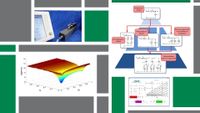Overview
Modern ventilators allow application of nearly unlimited number of different ventilation modes. Unfortunately, this variety leads to an increased complexity in operating the ventilator. Moreover, mechanical ventilation can lead to ventilator induced lung injury implying deathly consequences for the patient. Thus, the therapeutical outcome of mechanical ventilation can be improved significantly by relieving the doctor from tuning the ventilator settings manually. Instead, clinicians should be allowed to set abstract goals that are automatically followed by the ventilator.
Current research at ITeM
The goal of model-based mechanical ventilation is to allow the doctor to set abstract therapy goals. Physiological models can be employed to predict patient reactions to changes in ventilator settings and therefore can be used to optimize those settings to meet the clinician’s goals. In addition, they provide supplementary information about a patient’s health by revealing physiological parameters that would otherwise be hidden. For that purpose, the models must be adaptable to each patient individually. To ensure robust parameter fitting models are organized in hierarchical structures where models of lower complexity are extended to create models of higher complexity. Thus each model is related to its parents (i.e. the less complex models) and children (i.e. the next complex models). Employing such a structure in the identification process allows to use knowledge from already identified models of low complexity to gain optimal initial conditions for the identification of complex models.
In order to create a system for medical decision support in mechanically ventilated patients, a detailed library of different physiological models is needed. These models should be classified in different model families and sorted with respect to detail and simulation focus. By providing a number of different models serving different clinical focus, always the models needed for the actual simulation goal can be chosen and can be combined to form a complex physiological model system. We implement various selection criteria to choose the model that best fits the current data and clinical scenario. Those criteria evaluate the complexity of the available models, their ability to reproduce the recorded data and the determination of the identified parameters.
Cooperations
- Dräger Medical Deutschland GmbH
- University of Canterbury, Department of Mechanical Engineering, Christchurch, New Zealand
- Hamilton Medical
- Budapest University of Technology, Department of Control Engineering and Information Technology, Hungary
- University of Liege, Belgium
